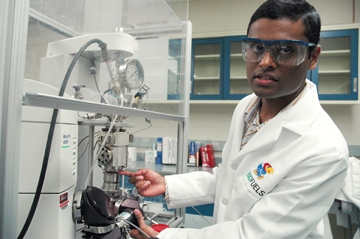Student Honored Nationally for Green Breakthrough

A University of Kansas doctoral student in chemical and petroleum engineering has won the prestigious Kenneth G. Hancock Memorial Award in Green Chemistry.
Madhav Ghanta is one of only two recipients in the nation to be selected by the American Chemical Society’s Green Chemistry Institute. He was presented with the honor June 21 in Washington, D.C., at the Presidential Green Chemistry Challenge Awards Ceremony held at the Ronald Reagan Building and International Trade Center.
Ghanta was recognized for his research at KU’s Center for Environmentally Beneficial Catalysis, where he was a key member of the team that developed a nature-friendly way to make ethylene oxide, a key industrial chemical, which could revolutionize production of antifreeze, plastic bottles, sports gear, detergents and paints by significantly reducing their carbon footprint.
“The current technology is wasteful,” said Ghanta. “Roughly 15 percent of the converted ethylene is lost to burning, producing 3.4 million tons of carbon dioxide — that’s equivalent to the pollution caused by 900,000 cars. The global demand for EO is increasing and as more plants are constructed, the amount of carbon dioxide produced will also increase proportionately.”
The technique spearheaded by Ghanta and Hyun Jin Lee, a postdoctoral researcher at the Center for Environmentally Beneficial Catalysis — dubbed “Pressure Intensified Light Olefin Epoxidation” — has the potential to radically alter the production of ethylene oxide by significantly conserving energy, minimizing waste and eliminating carbon dioxide emissions.
“The only side product formed is water, which is environmentally acceptable,” Ghanta said.
The KU graduate student said that his research is inspired by the needs of industry, along with a deep-seated hope to perform work that is beneficial to society at large.
“A majority of the commercially practiced technologies are not environmentally sustainable as developed during the last century,” said Ghanta. “Incidents like the Bhopal gas leak are a stark reminder of the extreme hazard that obsolete technologies pose to humans and the environment.”
Through the Center for Environmentally Beneficial Catalysis, KU has a hand in patenting the new, nature-friendly technology. A unique industrial partnership program exists between the center and its corporate members in which companies provide guidance on a project and receive access to resulting technologies along with priority licensing opportunities for approaches developed at the the center.
Ghanta’s faculty mentors, Bala Subramaniam, the Dan F. Servey Distinguished Professor of Chemical and Petroleum Engineering, and Daryle Busch, the Roy A. Roberts Distinguished Professor of Chemistry, were both on hand in the nation’s capital to see him accept the award.
“The elimination of carbon dioxide formation in CEBC’s ethylene oxide technology represents an important breakthrough in solving a major grand challenge in industrial chemistry,” said Subramaniam. “Madhav’s ingenious experimental work and sound engineering calculations were critical to demonstrate significantly increased productivity and safe operation of the novel CEBC technology.”
“We’re deeply pleased that graduate student Madhav Ghanta has been singled out for the Hancock Award in Green Chemistry,” said Busch. “This is a high honor for our young colleague. It will mark him as a talented and dynamic new professional to watch grow. As a member of a research team, Madhav is partnering in developing a commercial process that is very important both economically and environmentally. The process presently practiced is among those most in need of replacement for safety, greening and, now, also economic reasons. Even beyond these initiatives, committed students like Madhav Ghanta make it more fun to share in their excitement as each new discovery is made.”
Ghanta also cites the assistance of Claudia Bode, education director at the Center for Environmentally Beneficial Catalysis, and Darryl Fahey, industrial liaison director at the center. Both were at the Washington, D.C., ceremony.
The Center for Environmentally Beneficial Catalysis’ mission is to develop cleaner, more efficient industrial processes to make chemicals and fuels.